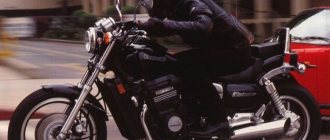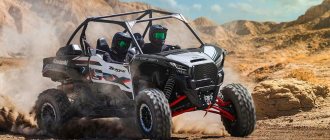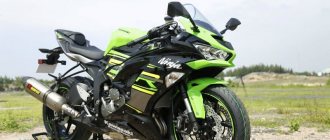| Kawasaki KLV 1000 (2004-2005) |
Touring enduro model Kawasaki KLV 1000
was published in 2004 and was produced until 2006. This model was created jointly with Suzuki and is essentially the same first generation Suzuki DL1000 V-Strom. The only differences are minor visual changes, such as the shape of the wings, windshield and bright orange color. The identity of motorcycles is so strong that in the documents KLV 1000 in the “clones” column of models from different manufacturers almost never enjoyed success. In addition, perhaps due to the third-party production of the model (all components, assemblies and components were from Suzuki), its final cost was clearly inflated and exceeded the price of the same V-Strom.
The main competitors of the Kawasaki KLV 1000 in the class:
- Honda XL1000V Varadero
- Suzuki DL1000 V-Strom
- Yamaha XT1200Z Super Tenere
Specifications
Technical characteristics of Kawasaki KLV 1000:
| Model | Kawasaki KLV1000 |
| Motorcycle type | touring enduro |
| Year of issue | 2004-2005 |
| Frame | aluminum spatial |
| engine's type | 2-cylinder, 4-stroke, V-shaped 90° |
| Working volume | 996 cm³ |
| Bore/Stroke | 98.0 x 66.0 mm |
| Compression ratio | 11.3:1 |
| Cooling | liquid |
| Number of valves per cylinder | DOHC, 4 valves per cylinder |
| Fuel supply system | injector, 2x 45 mm |
| Ignition type | transistor |
| Maximum power | 98.0 hp (72 kW) at 7600 rpm |
| Maximum torque | 101 Nm (10.2 kg*m) at 6400 rpm |
| Clutch | Multi-disc in oil bath, hydraulic drive |
| Transmission | 6-speed |
| type of drive | chain |
| Front tire size | 110/80 R19 M/C 59H |
| Rear tire size | 150/70 R17 M/C 69H |
| Front brakes | 2 discs, 310 mm, 2-piston calipers |
| Rear brakes | 1 disc, 260 mm, 1-piston caliper |
| Front suspension | 43 mm telescopic fork, travel - 160 mm |
| Rear suspension | pendulum with monoshock absorber (adjustable preload and rebound), stroke - 159 mm |
| Motorcycle length | 2295 mm |
| Motorcycle width | 910 mm |
| Motorcycle height | 1395 mm |
| Wheelbase | 1535 mm |
| Seat height | 840 mm |
| Minimum ground clearance | 165 mm |
| Acceleration 0-100 km/h (0-60 mph) | 3.9 sec[1] |
| Maximum speed | 217 km/h[2] |
| Gas tank capacity | 22.0 l |
| Motorcycle weight | 208 kg - dry 237 kg - loaded |
The main brands of police motorcycles today are Harley-Davidson, BMW, Honda, Yamaha and Kawasaki. Moreover, the Kawasaki KZ1000P, produced from 1981 until 2005, was a strong competitor to the Harley-Davidson Electra Glide Police. Even now there are motorcycles from those years that successfully perform their tasks. Kawasaki police motorcycles were mass-produced from 1975 to 2005. The first police Kawasaki Z1-P was a serial Kawasaki Z1 900 with a set of police options installed; in 1975 it was installed in police garages, and from 1976 it began to be installed at the factory. In 1977, the KZ900 Police Special began to be produced, using the KZ900 motorcycle as the basis. From 1978 to 1981, the KZ1000C Police was produced - this was the first model designed specifically for police service and competed with Harley-Davidson; in 1982 it was modernized into the KZ1000P Police and was produced right up to 2005! This is the most common model, commonly known as KZP. Now the Kawasaki Concours 14 (GTR1400) is being produced, if I’m not mistaken, it began to be produced in 2008, the police version based on it is still being finalized.
Let's return to the Kawasaki KZ1000P, a motorcycle that has been in production for almost 25 years is worth a look. And he had attention! He can be seen in many American films of the 80s-90s. In almost all of them, the cops ride either one or a Harley. There are, of course, other tales, but rather as an exception. Everyone knows that Arnie rode a Harley FatBoy in Terminator 2, but not everyone knows that the liquid metal terminator rode a patrol Kawasaki KZ1000P!
Characteristics of Kawasaki KZ1000P (KZP)
- Years of production 1982-2005
- Engine 4-stroke, 4-cylinder in-line, DOHC, 2 valves per cylinder
- Volume 998 cc
- Electric starter
- Bore and stroke 69.4 x 66.0 mm
- Air-oil cooling
- Power 88hp at 9000 rpm
- Maximum torque 152 Nm at 8000 rpm
- Mikuni BS34 carburetors
- Ignition Transistor (TCBI)
- 5-speed gearbox
- Multi-plate clutch in oil bath, slip system
- Chain drive
- Duplex frame, high quality steel
- Tilt angle, trail - 27 degrees and 110 mm
- Front suspension 38 mm telescopic hydraulic fork
- Rear suspension pendulum with two adjustable shock absorbers
- Front tire MN 90-18 4PR
- Rear tire MR 90-18 4PR
- Brakes: front double-disc hydraulic, rear single-disc hydraulic
- Tank capacity 17 l
- Total length 2290 mm
- Width 890 mm
- Height 1560 mm
- Ground clearance 160 mm
- Seat height 780 mm
- Curb weight 270 kg
The motorcycle was single-seater, equipped with a standard set of options for patrol officers: a windshield, side and central trunks, special signals and footrests instead of footrests, and could carry and ensure the functionality of police radios and other communication equipment.
The engine is an in-line four-stroke four-cylinder with two camshafts with a chain drive in the cylinder head. To meet increased needs, the generator power has been increased. The KZ1000C and KZ1000P motorcycles were equipped with special Dunlop tires, which allowed them to continue driving in the event of a puncture. Such tires significantly increased safety, allowing you to avoid falling and safely decelerate in the event of a tire failure at high speed. However, the very thick sidewalls of these tires transferred much more vibration from the road surface to the motorcycle controls, increased fuel consumption and wore out quickly, which forced the switch to regular Metzeler tires. 1989 Kawasaki KZ1000P
The most noticeable difference between the KZP and earlier models is the fiberglass fairing, with built-in front warning lights and windshield. Thanks to the original fairing profile, the KZP has become the most recognizable among other patrol motorcycles. Earlier Kawasaki patrol cars had a windshield similar to the old Harley-Davidson Electra Glide, which was once popular among lawmen. KZP had over 95% parts compatible with earlier models. In general, the design of these motorcycles remained unchanged, only in 2002 the chain size was reduced to reduce weight and improve dynamic properties. And in 2003, the “P” series received LED special signals.
The motorcycle is distinguished by stable and flexible engine operation, fast acceleration and a comfortable seating position. However, with 270kg of weight and almost 90 horses, this is not a bike for beginners. Private buyers advise taking advanced riding courses, like those offered to police officers.
The motorcycle is equipped with chrome roll bars at the front and bars surrounding the side panniers and rear fender. The top of the windshield has the worst visibility, since the edge of the glass is in the driver's primary line of sight. Another feature is that the bike is revving, it constantly needs to be tightened. The saddle is comfortable even after long rides, the platforms allow you to move your legs in different positions for comfort. Due to the radio mount, there is no passenger seat, but if you remove it, you can install a full two-seater saddle. Handling is very dependent on correct tire pressure. Kawasaki produced Police Special motorcycles for North America at the Lincoln plant in Nebraska, USA. The last one was released in September 2005. Today, these motorcycles are still used by most US law enforcement agencies, as well as private organizations providing VIP escort services.
History of changes
Of course, such a long production history could not pass completely without changes:
- 1986 – appearance of the model;
- 1994 – creation of the second generation;
- 2003 – last year of production for Europe;
- 2006 is the last year of production.
The motorcycle managed to become a “long-liver” in the conditions of enormous competition that developed closer to the 2000s in the field of sports motorcycles. This model can hardly be called a legend. The motorcycle is just a good average bike in its niche.
Dimensions and weight
The bike is not very long compared to the average cruiser, but for a sports bike it is quite large: its length is 2290 millimeters, its width is 930 millimeters, and its height is 1415 millimeters. The height of the motorcycle at the saddle reaches 790 millimeters. The wheelbase size is 1555 millimeters.
The weight of this bike reaches 307 kilograms. This is its curb weight. You can't call it easy. Rather, it is a heavyweight among sports motorcycles. Be that as it may, such weight is not a disadvantage of the model, because this is a consequence of its concept: yes, the bike is certainly sporty, but still it is intended not only for an urban environment, but also for long trips along country roads.
MotoRelic Workshop
Sean Skinner of Virginia-based MotoRelic is known for his thoughtful, colorful designs. Last year he worked on a '79 Kawasaki KZ1000 for a client who inherited the bike from his uncle and wanted to restore it to its former glory with a custom flair:
We settled on a classic brat custom that was comfortable enough to travel across the country.
And then the principle of word of mouth worked: if you do a job well for one, another will come to you, and soon Sean received a call from a potential customer named Bob Kelly, who was so amazed by the Kawasaki KZ '79 that he wanted the same or almost the same, and I asked if it was possible to look for a donor already. At first, Sean didn’t want to take it on because of a couple of difficult moments in the previous project, but after thinking about it, he agreed to take it on, with three conditions:
Spoke wheels, side covers and no silver! The customer was completely on board, we found a '78 Kawasaki KZ already on spokes and he had it shipped from Colorado.
The result is simply stunning - bright coral Raptor Red shines on the tank of a Royal Enfield Continental GT, heavily modified to fit a Kawasaki KZ. In appearance and size, this tank was perfect, but its internal tunnel had to be completely redone, and then additional fasteners were welded to the spine of the Kawasaki KZ frame.
Restomod Kawasaki KZ1000
Chassis and brakes
The motorcycle frame is made of high quality steel. With its characteristic shape it reflects his sporting status. Sports alloy wheels give the wheels a stylish look. The medium-sized steering wheel provides the car with good handling.
At the rear there is a pendulum suspension with a monoshock absorber. It has a stroke of 140 millimeters. The front suspension is a 41mm telescopic fork with a travel of 140mm. The rear brakes feature a 280mm disc accompanied by a single-piston caliper. At the front there are two discs, each 300 millimeters, and they are equipped with two-piston calipers.
Engine
The car has an in-line engine. This is a four-stroke, four-cylinder unit with a displacement of 997 cubic centimeters. At 6500 rpm it produces a torque of approximately 83 Newton meters. The maximum power of this machine averages 85 horsepower at 9500 rpm.
The motorcycle reaches a maximum speed of 216 kilometers per hour. For a sports bike, this is a very average figure, but it’s difficult to call it small. Acceleration is relatively average and is 4.4 seconds (up to 100 kilometers per hour). Fuel consumption is approximately 6.5 liters per 100 kilometers, but this value depends on driving style. The gas tank capacity is huge - as much as 28.5 liters.









